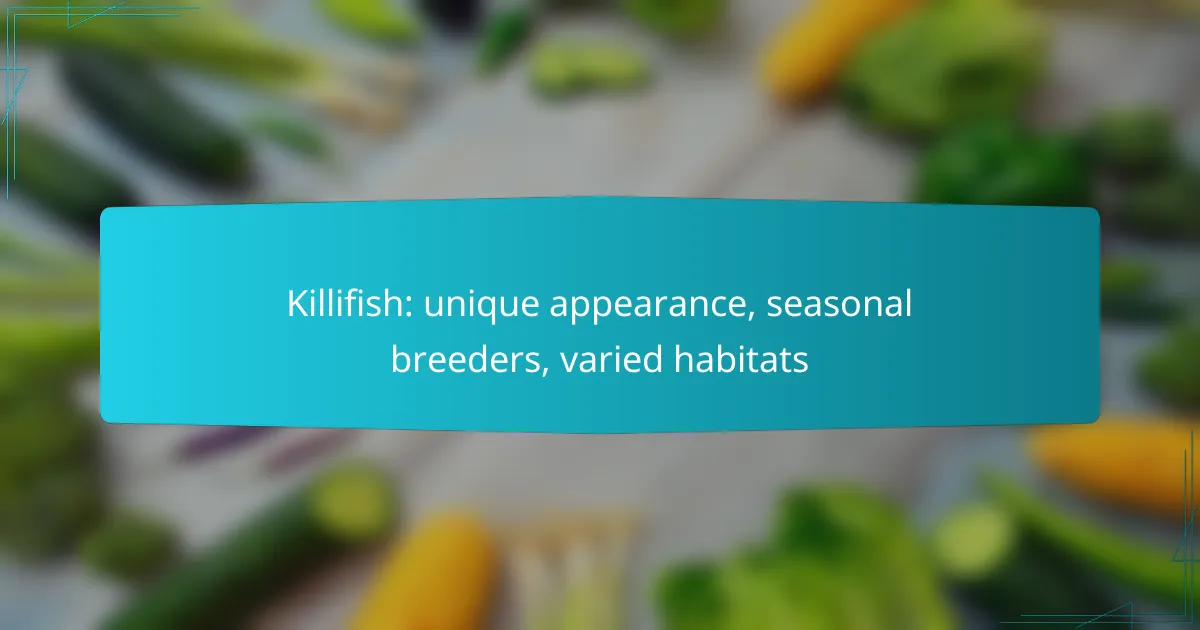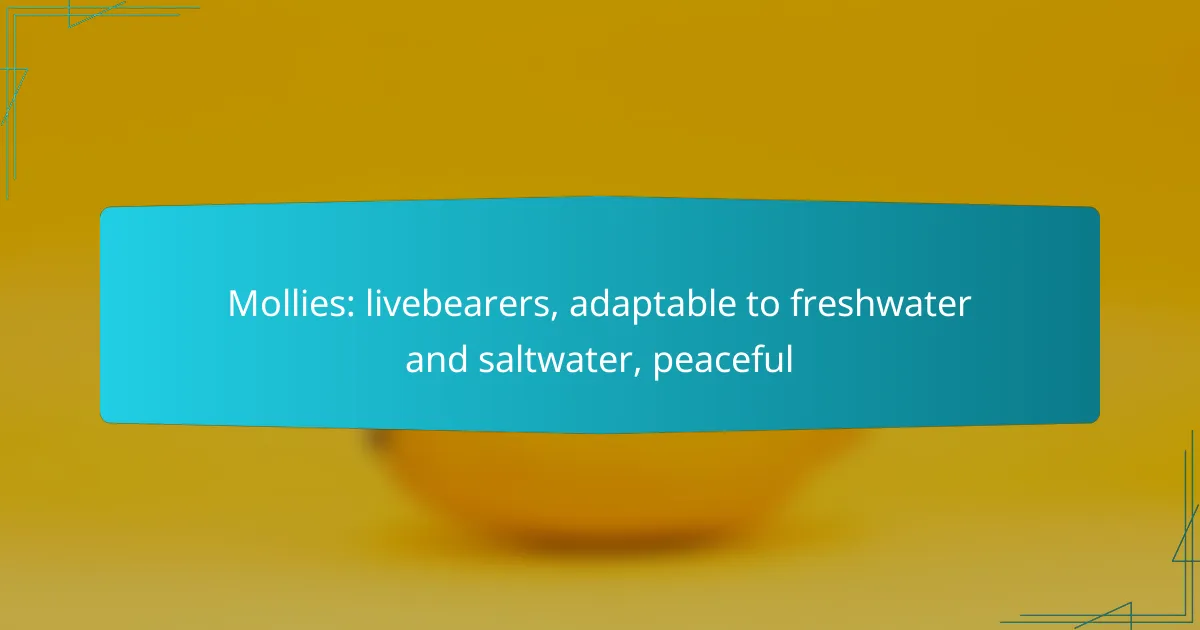Killifish are captivating freshwater and brackish fish known for their vibrant colors and diverse body shapes. As seasonal breeders, they exhibit unique reproductive strategies that allow them to thrive in a variety of habitats, from ponds to coastal marshes. Their adaptability and striking appearance make them a popular choice for both aquarists and researchers.

How to care for killifish in home aquariums?
Caring for killifish in home aquariums involves providing the right environment, diet, and tank mates. These unique fish thrive in specific water conditions and require a balanced diet to stay healthy.
Optimal water conditions
Killifish prefer soft, slightly acidic to neutral water, with a pH range of about 6.5 to 7.5. The temperature should be maintained between 22°C and 28°C (72°F to 82°F) to ensure their comfort and health.
Regular water changes, around 10-20% weekly, help maintain water quality. Use a filter that does not create strong currents, as killifish are not strong swimmers and prefer calm waters.
Feeding requirements
Killifish are omnivorous and benefit from a varied diet. High-quality flake food, frozen or live foods like brine shrimp and daphnia, should be included to provide essential nutrients.
Feed them small amounts 1-2 times a day, ensuring they consume everything within a few minutes to prevent overfeeding and water quality issues.
Tank mates compatibility
When selecting tank mates for killifish, choose peaceful species that occupy different water levels, such as small tetras or rasboras. Avoid aggressive fish that may stress or harm them.
Ensure that the tank is spacious enough to accommodate all species comfortably, with plenty of hiding spots to reduce territorial disputes.
Breeding setup
To breed killifish, set up a separate breeding tank with fine-leaved plants or spawning mops where females can lay eggs. Maintain slightly acidic water conditions and a temperature around 24°C (75°F).
After spawning, remove the adults to prevent them from eating the eggs. The eggs typically hatch within a week, and the fry should be fed infusoria or finely crushed flakes until they grow larger.

What are the unique features of killifish?
Killifish are distinguished by their vibrant colors, diverse body shapes, and adaptability to various habitats. These small fish exhibit unique traits that make them fascinating for aquarists and researchers alike.
Color variations
Killifish display a wide range of color variations, often characterized by bright hues and intricate patterns. Species like the golden killifish showcase brilliant yellows and oranges, while others may exhibit striking blues and greens. These colors can serve purposes such as camouflage or attracting mates.
In captivity, the color intensity can be influenced by factors such as diet, water quality, and lighting. Providing a varied diet rich in carotenoids can enhance their natural coloration.
Body shapes
The body shapes of killifish can vary significantly across species, with some exhibiting elongated, streamlined forms while others are more robust and rounded. This diversity allows them to thrive in different environments, from shallow ponds to fast-flowing streams.
Understanding the body shape can help aquarists create suitable habitats. For instance, species with elongated bodies may require more swimming space, while those with stockier builds may prefer denser vegetation for hiding.
Size differences
Killifish sizes can range from just a few centimeters to over 15 centimeters in length, depending on the species. Smaller varieties, like the Micropanchax, are often under 5 centimeters, making them ideal for nano aquariums.
When selecting killifish for an aquarium, consider the size of the tank and the potential adult size of the fish. Ensuring adequate space is crucial for their health and well-being, as overcrowding can lead to stress and aggression.

Where do killifish thrive in the wild?
Killifish thrive in a variety of aquatic environments, including freshwater and brackish habitats. Their adaptability allows them to occupy diverse ecosystems, from ponds to coastal marshes.
Freshwater habitats
Freshwater habitats are among the primary environments where killifish are found. They inhabit shallow waters such as streams, ponds, and lakes, often preferring areas with abundant vegetation. This vegetation provides cover and breeding sites, making these environments ideal for their life cycle.
In freshwater settings, killifish are often seen in slow-moving or stagnant waters. They can tolerate a range of water conditions, including varying temperatures and pH levels, which enhances their survival in diverse ecosystems.
Brackish environments
Brackish environments, where freshwater meets saltwater, are another key habitat for killifish. These areas, such as estuaries and coastal lagoons, provide unique breeding opportunities and food sources. Killifish can adapt to the fluctuating salinity levels typical of these environments.
In brackish waters, killifish often thrive in areas with dense vegetation and mudflats, which offer protection from predators. Their ability to tolerate salinity variations allows them to exploit these transitional zones effectively.
Geographical distribution
Killifish are distributed widely across the globe, with species found on every continent except Antarctica. They are particularly abundant in North America, South America, and parts of Africa and Asia. This broad geographical distribution reflects their adaptability to various climates and habitats.
In North America, for example, killifish species such as the Fundulus heteroclitus are commonly found along the Atlantic coast, while in South America, species thrive in the Amazon basin. Their presence in diverse regions highlights their ecological versatility and resilience.

How do seasonal breeding patterns affect killifish?
Seasonal breeding patterns significantly influence killifish reproduction, affecting their life cycles and population dynamics. These patterns are closely tied to environmental conditions, which dictate when and how often these fish breed.
Breeding cycles
Killifish typically exhibit distinct breeding cycles that align with seasonal changes in their habitats. Many species breed during specific times of the year when conditions are optimal, such as warmer temperatures and increased food availability. This can lead to multiple spawning events within a single season, allowing for rapid population growth.
In temperate regions, breeding often coincides with spring and early summer, while in tropical areas, breeding may occur year-round but can peak during rainy seasons. Understanding these cycles is crucial for effective management and conservation efforts.
Environmental triggers
Environmental factors such as temperature, rainfall, and water quality serve as key triggers for the breeding of killifish. For instance, rising water temperatures can signal the onset of the breeding season, prompting males to establish territories and attract females. Similarly, increased rainfall can lead to flooding, creating new habitats that are ideal for spawning.
Monitoring these environmental cues can help aquarists and researchers predict breeding times and improve breeding success in captivity. Providing optimal conditions, such as stable water parameters and appropriate temperatures, is essential for encouraging successful reproduction.

What are the best killifish species for beginners?
For beginners interested in keeping killifish, two excellent species to consider are Fundulopanchax sjoestedti and Aphyosemion striatum. These species are known for their vibrant colors, manageable care requirements, and adaptability to various environments.
Fundulopanchax sjoestedti
Fundulopanchax sjoestedti, commonly known as the golden lampeye, is a popular choice for novice aquarists. This species thrives in a range of water conditions, making it easy to care for in home aquariums.
They prefer slightly acidic to neutral pH levels and a temperature range of 22-28°C. Providing a well-planted tank with plenty of hiding spots will help them feel secure and encourage natural behaviors.
When feeding, a varied diet of high-quality flakes, frozen foods, and live foods will keep them healthy and vibrant. Regular water changes and monitoring for any signs of stress or disease are essential for maintaining their well-being.
Aphyosemion striatum
Aphyosemion striatum, or the striped killifish, is another beginner-friendly species known for its striking appearance and ease of care. This fish prefers slightly warmer water, ideally between 24-30°C, and a pH around 6.5-7.5.
Creating a densely planted aquarium with floating plants can mimic their natural habitat and provide them with shelter. They are relatively peaceful but can be territorial during breeding, so ensure adequate space and hiding spots.
Feeding Aphyosemion striatum a balanced diet of flakes, pellets, and occasional live or frozen foods will promote vibrant colors and good health. Regular tank maintenance and monitoring for compatibility with tank mates are crucial for a harmonious aquarium environment.

How to set up a breeding tank for killifish?
Setting up a breeding tank for killifish requires careful consideration of size, water parameters, and environment. These fish thrive in specific conditions that promote breeding and ensure the health of both adults and fry.
Tank size recommendations
A breeding tank for killifish should ideally be at least 10 to 20 gallons to provide ample space for swimming and breeding. Smaller tanks can lead to overcrowding, which can stress the fish and hinder breeding success.
Consider using a tank with a shallow depth, as killifish prefer to breed near the surface. If you plan to keep multiple pairs, a larger tank will help maintain water quality and reduce territorial disputes.
Water parameters
Maintaining the right water parameters is crucial for killifish breeding. The ideal temperature range is typically between 22°C to 28°C (72°F to 82°F), with a pH level around 6.5 to 7.5. Regular monitoring of these conditions will help create a stable environment.
Additionally, soft water is preferred for breeding, as it mimics their natural habitats. Use a water conditioner to remove chlorine and chloramines, and consider adding a sponge filter to maintain water quality without creating strong currents that could disturb the fish.










